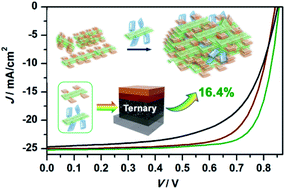A 16.4% efficiency organic photovoltaic cell enabled using two donor polymers with their side-chains oriented differently by a ternary strategy†
Abstract
Effective ternary material systems are usually achieved using a donor/acceptor guest that is structurally similar to the donor/acceptor host to maintain the film-morphology of the host binary blend. In this study, we report an unprecedented ternary material system, PBDB-TF:PBDB-T-SF:Y6, in which PBDB-T-SF is selected as the donor polymer guest of the PBDB-TF:Y6 binary blend. The absorption spectra of both polymers are almost overlapped and their energy levels are similar. However, the side-chains between the host (PBDB-TF) and the guest (PBDB-T-SF) are oriented differently, which modulates the morphology of the polymer phases from nanoscale (10–20 nm) fine fibrils in the host binary blend to an interpenetrating mesoscale polymer-crowd (>100 nm) with reduced phase crystallinity in the ternary blend. As a result, the electrical properties of the active layer are greatly improved: the hole mobility increases more than the electron mobility, resulting in balanced hole and electron mobilities; the monomolecular and bimolecular recombinations are both reduced; the charge carrier extraction is faster and the trap-assisted recombination is reduced, resulting in a longer recombination lifetime of charge carriers (0.19 μs vs. 0.15/0.11 μs). All of these contribute to the concurrently increased device fill-factor and short-circuit current-density, and finally improved efficiency (16.4%). Solid-state 19F magic angle spinning nuclear magnetic microscopy is conducted to probe interaction between the host and guest donor polymers. This study demonstrates that mesoscale morphology such as the polymer-crowd induced by differently oriented side chains of the host–guest polymers can be a morphological feature of active layer toward high-efficiency organic photovoltaic cells.

- This article is part of the themed collection: Journal of Materials Chemistry A HOT Papers


 Please wait while we load your content...
Please wait while we load your content...